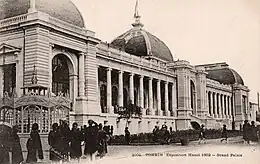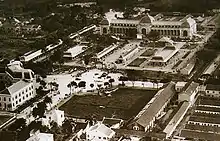| 1902–1903 Hanoi | |
|---|---|
 Grand Palais d'Expositions | |
| Overview | |
| BIE-class | Unrecognized exposition |
| Name | Indo China Exposition Française et Internationale |
| Building(s) | Palais d'expositions designed by Adolphe Bussy |
| Area | 41 acres (17 hectares) |
| Organized by | Paul Doumer |
| Location | |
| Country | French Indochina (now Vietnam) |
| City | Hanoi |
| Coordinates | 21°02′22″N 105°50′04″E / 21.0393206°N 105.8343995°E |
| Timeline | |
| Opening | 15 November 1902 |
| Closure | 15 or 16 February 1903 |
| History of Hanoi |
|---|
 |
| Timeline |
|
|
The Hanoi Exhibition (Exposition de Hanoi) was a world's fair[1] held in Hanoi in then French Indochina between November 16, 1902,[1] and February 15[2] or 16,[1] 1903.
Context
Hanoi had become the capital of French Indochina earlier in 1902 replacing Saigon. Earlier activities to mark the change included a festival on 26 February 1902 attended by emperor Thành Thái and the governor general Paul Doumer[2] and the opening of the Paul Doumer (now Long Biên) Bridge.[2] The exhibition was the idea of Paul Doumer.[3]
Grand Palais de l'Exposition

The site of the fair was the racecourse established in the early 1890s,[3] and its main building was the Grand Palais de l'Exposition (Vietnamese: Nhà Đấu xảo) designed by Adolphe Bussy.[4]
The preparation for the fair, especially the construction of the exhibition palace, left Hanoi's budget in deficit for a decade.[3]
When the Japanese took over Vietnam, they based their military and supply in the palace. Later, air raids at the end of World War II completely destroyed the building.[4]
The modern site of the palace now stands the Friendship Cultural Palace (Vietnamese: Cung Văn hoá Hữu nghị), a concert venue in southern Hoàn Kiếm District.
Participation
The fair showed products from France and her colonies, and from other territories in Southeast Asia: , Burma,[2][5] Ceylon, China, Dutch Indies, Formosa (now Taiwan), French Indo-China, India, Japan, Korea,[5] Malaysia, Malacca, the Philippines, Siam and Singapore.[2][5]
Exhibits
As well as country displays there was a machine gallery,[6] a La Grand Roue amusement ride,[7] and art in the French Section of Fine Arts including work by Carolus-Duran.[4]
References
- 1 2 3 Pelle, Findling, ed. (2008). "Appendix B:Fair Statistics". Encyclopedia of World's Fairs and Expositions. McFarland & Company, Inc. p. 415. ISBN 978-0-7864-3416-9.
- 1 2 3 4 5 "1902 L'exposition de Hanoi World Expo" (in French). Retrieved July 28, 2015.
- 1 2 3 Logan, William Stewart. Hanoi: Biography of a City. p. 93.
- 1 2 3 Huan Do, Hanoi Colonial Buildings
- 1 2 3 "L'Indochine Coloniale - Exposition d'Hanoi 1902" (in French). Retrieved July 20, 2015.
- ↑ "Hanoï la vie.com | Evenements | 1902 Exposition Galerie Des Machines.jpg" (in French). Retrieved 28 July 2015.
- ↑ "Hanoï la vie.com | Evenements | 1902 Exposition La Grande Roue.jpg" (in French). Retrieved 28 July 2015.